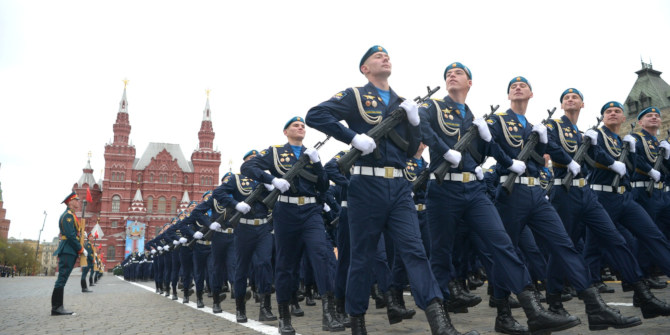On 21 July, the European Central Bank decided to raise interest rates for the first time since 2011 in a bid to curb inflation. With further rate rises potentially on the horizon, Philipp Heimberger and Lea Steininger argue that climate protection policies could be an unexpected casualty from the central bank’s shift in approach.
Widespread forest fires, melting glaciers, heat waves… the effects of the climate crisis have hit large parts of Europe and the world over the summer. Due to the consequences of the climate catastrophe, half of humanity now lives in an immediate danger zone for their own lives. Even in Europe, large regions could soon be barely habitable. Investments of hundreds of billions of euros in clean technologies, environmentally friendly energy supply, climate-friendly infrastructure and mobility will be required to phase out fossil fuels and achieve climate neutrality.
Amid the heat records, the European Central Bank decided on 21 July to raise its key interest rate by 0.5 percentage points. Raising policy rates has the effect of lowering demand and employment with the primary goal of curbing inflation: firms lower investments due to higher financing costs, unemployment goes up, and wages and income levels decline with a lag. Notwithstanding the intention, attempting to manage inflation by chopping off demand does not address the supply-side driven reasons for current high price indices. Rather, higher prices are imported due to the impact of the Russian invasion of Ukraine on energy markets, the market power of the oil industry, and the impact of the war and the Covid-19 pandemic on global supply chains.
ECB interest rate hikes cannot increase the supply of gas from Russia, nor can they open up alternative energy sources or solve supply chain problems for chips and semiconductors. However, they will cause collateral damage. In the process, in addition to elevated unemployment, which poses a substantive problem for democracy and societal cohesion on its own, the climate policy agenda will be particularly affected.
A climate-friendly transformation requires a shift from technologies with high operating costs in fuels and labour to technologies with high capital expenditures. A different business model is thus required. For example, while a gas-fired power plant may use its ongoing revenues to pay for new fuel, an offshore wind project uses its ongoing revenues to service debt incurred for capital expenditures. The higher the cost of capital, the less attractive an offshore wind farm is. Higher interest rates are therefore a problem for the green transformation.
On the need for public investment
Investments have to be pushed by the state through reliable public investment plans as well as sensible regulations. Only improved infrastructure and planning security can encourage private companies to expand into climate-friendly sectors.
However, most climate investments are not profitable in a classic economic sense. For example, private companies will refrain from building the infrastructure for emission-reducing public transport if they will subsequently operate this infrastructure without making a profit. On top of building infrastructure, the public sector will have to also set the direction through industrial policy. This includes, for instance, planning and co-financing production structures for modern high-speed trains to reduce air traffic in the medium term, and actively promoting renewable energy.
The ECB’s strategy
In 2021, the ECB adapted its monetary policy strategy by promising to pay specific attention to interaction effects between its monetary policy and environmental and climate policies. In doing so, it pledged to consider a number of factors that should make it reluctant to hike interest rates. The ECB’s primary mandate is price stability; its secondary mandate is to support the EU’s general economic policy. The active promotion of more ambitious climate policies is in fact a key priority for achieving both mandates.
On the one hand, further interest rate hikes in autumn could destabilise fragmented Eurozone sovereign bond markets yet again by putting individual member states in financing and liquidity stress, thus forcing the ECB to intervene. The new ECB bond purchase programme (the ‘Transmission Protection Instrument’) announced on 21 July is intended to stabilise capital markets for exactly this reason. However, it is conditional on member states complying with outdated EU fiscal rules, which are temporarily suspended.
It is all the more urgent therefore to quickly reform the EU’s fiscal rules so that the scope for climate policy measures is expanded. After all, euro member states now live under the constant risk of their financing costs rising massively due to exclusion from the ECB’s new bond-buying programme (should the fiscal rules be reinstated). Otherwise, there will be massive yet unnecessary restrictions on additional public spending to tackle climate change.
Second, the climate crisis also directly affects price stability. After all, fossil fuels are the largest contributors to price increases. Accordingly, investments in clean energy will substantively strengthen price stability. Renewable energy sectors are thus key. However, they require large up-front investments and are sensitive to deteriorating financing conditions. If urgently needed investments were cancelled today due to higher interest rates, Europe would in the near future be even more vulnerable to the negative effects of the climate crisis. Only a rapid socio-ecological transformation can bring far-reaching stability.
Investments in (price) sustainability
The ECB cannot solve the climate crisis and energy system issues on its own. Effective climate and energy policies are in the hands of democratically elected politicians with control over fiscal policies. However, by affecting investment costs and business cycle developments through its actions, the central bank is a major player when it comes to the direction and options for climate and energy policy.
A series of interest rate hikes would undermine important EU goals such as energy security and decarbonisation. Moreover, interest rate hikes cannot address the root causes of the inflation we are experiencing. They work by throttling employment and will thereby exacerbate the current downturn. Strong energy and climate investment on favourable financing terms in the eurozone is central to achieving economic and social stability, and price stability in particular. It is up to the ECB to promote these investments rather than torpedo them.
Note: This article gives the views of the authors, not the position of EUROPP – European Politics and Policy or the London School of Economics. Featured image credit: European Central Bank (CC BY-NC-ND 2.0)





